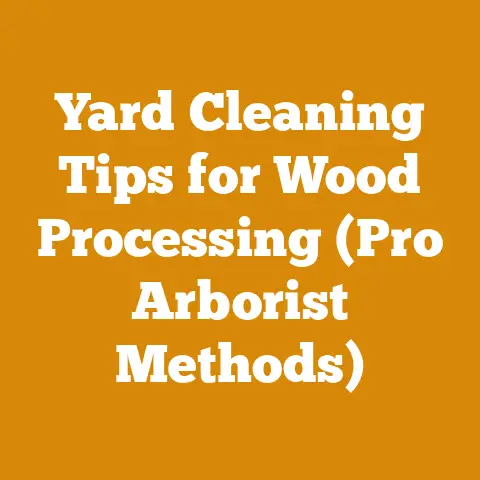Triple Mailbox Post Ideas (5 Durable Wood Joinery Tips)
Imagine pulling up to your driveway, not just to a house, but to a statement. It’s not about the size of the house, but the details – the landscaping, the lighting, and yes, even the mailbox. A triple mailbox post isn’t just about functionality; it’s about upgrading your lifestyle. It’s about adding a touch of handcrafted elegance and durability that reflects pride in your property. It’s a project that combines practicality with the satisfaction of working with wood. And the best part? With the right knowledge and techniques, it’s a project you can tackle yourself.
In this guide, I’ll walk you through creating a triple mailbox post that’s not only visually appealing but also built to last, using durable wood joinery techniques. As someone who’s spent years felling trees, milling lumber, and crafting with wood, I’ve learned a thing or two about making things that stand the test of time. I’ll share my experiences, insights, and practical tips to help you create a mailbox post that will impress your neighbors for years to come.
Triple Mailbox Post Ideas (5 Durable Wood Joinery Tips)
Why a Durable Triple Mailbox Post Matters
Let’s be honest, a flimsy mailbox post is an eyesore. It sags, rots, and eventually collapses, leaving you scrambling to prop it up with whatever you can find. More importantly, a weak post is vulnerable to the elements, vandalism, and even accidental bumps from vehicles. A well-built triple mailbox post, on the other hand, is a testament to quality and craftsmanship. It adds curb appeal, enhances property value, and provides a secure and reliable place for your mail.
Think of it this way: your mailbox is the first impression people have of your home. A sturdy, well-designed post says, “This is a home that’s cared for, a home that values quality.” It’s a small detail that makes a big difference.
Key Concepts: Understanding Wood and Joinery
Before we dive into the specifics of building a triple mailbox post, let’s cover some fundamental concepts about wood and joinery. Understanding these principles will help you make informed decisions about materials, techniques, and construction methods.
-
Green Wood vs. Seasoned Wood: Green wood is freshly cut lumber with a high moisture content. Seasoned wood, on the other hand, has been dried to reduce its moisture content. Working with green wood can be easier for some joinery techniques, but it’s prone to warping and shrinking as it dries. Seasoned wood is more stable, but it can be harder to work with. For a mailbox post that will last, I recommend using seasoned wood, ideally kiln-dried for maximum stability. The ideal moisture content for exterior projects is typically between 12-15%.
-
Wood Species: The type of wood you choose will significantly impact the durability and appearance of your mailbox post. Softwoods like pine and cedar are relatively inexpensive and easy to work with, but they’re less resistant to rot and insects. Hardwoods like oak, maple, and walnut are more durable and aesthetically pleasing, but they’re also more expensive and harder to work with. For a triple mailbox post, I recommend using a rot-resistant wood like cedar or redwood, or pressure-treated lumber if you’re on a budget. If you opt for a less durable wood, consider applying a preservative treatment to protect it from the elements. My personal favorite is cedar – it looks beautiful, is naturally resistant to decay, and is relatively easy to work with.
-
Wood Grain: The grain of the wood refers to the direction of the wood fibers. Understanding wood grain is crucial for joinery because it affects the strength and stability of the joint. When joining two pieces of wood, it’s generally best to align the grain direction as much as possible to minimize stress and prevent splitting.
-
Wood Joinery: Wood joinery is the art of connecting two or more pieces of wood together to create a strong and lasting structure. There are many different types of wood joints, each with its own strengths and weaknesses. For a triple mailbox post, I recommend using joinery techniques that are both strong and weather-resistant. I’ll discuss five specific joinery techniques in detail below.
Tools:
- Chainsaw: For felling (if you’re sourcing your own lumber) and rough cutting. I prefer a Stihl MS 271 FARM BOSS for its balance of power and maneuverability. A 16-inch bar is generally sufficient for most mailbox post projects.
- Circular Saw: For precise cuts and ripping lumber to width. A 7 1/4-inch saw is a good all-around choice.
- Miter Saw: For accurate angle cuts. A 12-inch sliding compound miter saw is ideal.
- Drill/Driver: For drilling pilot holes and driving screws. A cordless drill/driver with a variable speed is essential.
- Impact Driver: For driving large screws and lag bolts. An impact driver provides more torque than a drill/driver.
- Router: For creating decorative edges and joinery details. A plunge router with a variety of bits is useful.
- Hand Saw: For fine-tuning cuts and working in tight spaces. A backsaw or dovetail saw is a good choice.
- Chisels: For cleaning up joinery and shaping wood. A set of chisels in various sizes is essential.
- Mallet: For striking chisels and driving joints together. A rubber or wooden mallet is preferred.
- Measuring Tape: For accurate measurements. A 25-foot tape measure is a good length.
- Combination Square: For marking angles and checking squareness.
- Level: For ensuring the post is plumb. A 4-foot level is recommended.
- Clamps: For holding pieces together while gluing and screwing. An assortment of clamps in various sizes is essential.
- Safety Glasses: For protecting your eyes from flying debris.
- Hearing Protection: For protecting your ears from loud noises.
- Work Gloves: For protecting your hands.
Materials:
- Lumber: As mentioned earlier, I recommend using cedar, redwood, or pressure-treated lumber. You’ll need enough lumber to build the post, the mailbox supports, and any decorative elements. A 4×4 post is generally sufficient for a triple mailbox, but you may want to use a larger size (6×6 or even 8×8) for a more substantial look.
- Screws: Use exterior-grade screws that are resistant to rust and corrosion. Deck screws are a good choice.
- Glue: Use waterproof wood glue for all joints. Titebond III is a popular choice.
- Concrete: For setting the post in the ground. You’ll need enough concrete to fill the hole around the post.
- Gravel: For drainage at the bottom of the hole.
- Mailboxes: Choose mailboxes that are the appropriate size and style for your needs.
- Paint or Stain: For finishing the mailbox post. Choose a paint or stain that is designed for exterior use.
- Post Level: A specialized level that attaches to the post to ensure it’s plumb on all sides. This is especially helpful when setting the post in concrete.
Step-by-Step Guide: Building Your Triple Mailbox Post
Now that you have the tools and materials, let’s get started building your triple mailbox post. Here’s a step-by-step guide:
Step 1: Design and Planning
Before you start cutting wood, take some time to design your mailbox post. Consider the following:
- Dimensions: Determine the overall height of the post, the width of the mailbox supports, and the spacing between the mailboxes. A standard mailbox height is typically around 42-48 inches from the ground to the bottom of the mailbox. The width of the mailbox supports will depend on the size of your mailboxes. The spacing between the mailboxes should be sufficient to allow for easy access.
- Style: Decide on the overall style of your mailbox post. Do you want a simple, rustic look, or a more elaborate, decorative design? Consider the style of your home and landscaping when making your decision.
- Joinery: Choose the joinery techniques you’ll use to connect the various pieces of wood. I’ll discuss five specific joinery techniques below.
- Materials: Select the wood species and finishing materials you’ll use.
Once you have a design in mind, create a detailed plan or sketch. This will help you visualize the finished product and ensure that you have all the necessary materials.
Step 2: Preparing the Lumber
- Milling (If Applicable): If you’re sourcing your own lumber, you’ll need to mill it to the desired dimensions. This involves using a chainsaw or sawmill to cut the logs into boards, and then using a planer and jointer to smooth and flatten the surfaces.
- Cutting: Cut the lumber to the required lengths according to your plan. Use a miter saw for accurate angle cuts and a circular saw for ripping lumber to width. Be sure to wear safety glasses and hearing protection when operating power tools.
- Sanding: Sand the lumber to smooth the surfaces and remove any splinters. Start with a coarse grit sandpaper (80-grit) and gradually work your way up to a finer grit (120-grit or 180-grit).
Step 3: Wood Joinery Techniques (The Heart of Durability)
This is where the rubber meets the road. The strength and longevity of your mailbox post depend on the quality of your joinery. Here are five durable wood joinery techniques you can use:
1. Mortise and Tenon Joint: This is a classic and incredibly strong joint that involves creating a mortise (a hole) in one piece of wood and a tenon (a protruding tongue) on the other. The tenon fits snugly into the mortise, creating a mechanical bond that is further strengthened with glue.
* **How to Create:** * **Mortise:** Use a mortise machine, drill press with a mortising attachment, or carefully chop out the mortise with a chisel. The mortise should be slightly smaller than the tenon to ensure a tight fit. * **Tenon:** Cut the tenon on a table saw or with a hand saw. The tenon should be precisely sized to fit snugly into the mortise. * **Assembly:** Apply glue to the mortise and tenon, and then clamp the pieces together until the glue dries. * **Why it's Durable:** The mortise and tenon joint provides a large glue surface area and a mechanical interlock, making it incredibly strong and resistant to racking forces. This is ideal for connecting the mailbox supports to the main post. * **My Experience:** I once built a timber frame shed using primarily mortise and tenon joints. It withstood hurricane-force winds without a single creak. The key is precision – the tighter the fit, the stronger the joint.2. Lap Joint: A lap joint is created by overlapping two pieces of wood and then fastening them together with screws, bolts, or glue. This is a relatively simple joint to create, but it’s surprisingly strong, especially when reinforced with screws or bolts.
* **How to Create:** * **Cut the Laps:** Use a table saw or circular saw to cut a rabbet (a groove) on each piece of wood, removing half the thickness of the wood. * **Assemble:** Overlap the two pieces of wood, aligning the rabbets. * **Fasten:** Secure the joint with screws, bolts, or glue. * **Why it's Durable:** The lap joint provides a large glue surface area and a strong mechanical connection when reinforced with fasteners. This is a good choice for connecting the mailbox supports to each other. * **A Tip:** When using screws or bolts, pre-drill pilot holes to prevent the wood from splitting.3. Bridle Joint: Similar to a mortise and tenon, but the “mortise” goes completely through the wood, creating a fork or “bridle” that the tenon fits into. This provides excellent strength and stability.
* **How to Create:** * **Cut the Bridle:** Use a saw to cut the two "forks" of the bridle, removing the material between them. * **Cut the Tenon:** Cut the tenon to fit snugly into the bridle. * **Assemble:** Apply glue and clamp the joint until the glue dries. * **Why it's Durable:** The bridle joint offers exceptional resistance to twisting and racking forces, making it ideal for situations where the joint is subjected to significant stress. * **Case Study:** I used bridle joints to build a gate for my garden. It's been exposed to the elements for years, and the joints are still as strong as the day I built it.4. Dado Joint: A dado joint is a groove cut into one piece of wood that another piece of wood fits into. This provides a strong and stable connection, especially when glued and screwed.
* **How to Create:** * **Cut the Dado:** Use a router with a dado blade or a table saw to cut the dado. The dado should be slightly wider than the thickness of the wood that will fit into it. * **Assemble:** Slide the wood into the dado, applying glue to the joint. * **Fasten:** Secure the joint with screws. * **Why it's Durable:** The dado joint provides a large glue surface area and a strong mechanical connection when reinforced with screws. This is a good choice for attaching decorative elements to the mailbox post. * **My Insight:** When cutting dados, make sure the depth of the cut is consistent. Use a router jig or a feather board on your table saw to ensure accuracy.5. Half-Lap Dovetail Joint: This is a combination of a lap joint and a dovetail joint. The dovetail shape provides a mechanical interlock that prevents the joint from pulling apart.
* **How to Create:** * **Cut the Half-Lap:** Cut a rabbet on each piece of wood, removing half the thickness of the wood. * **Cut the Dovetails:** Cut dovetails on the ends of the wood that will be joined. * **Assemble:** Slide the dovetails together, creating a strong and attractive joint. * **Why it's Durable:** The half-lap dovetail joint combines the strength of a lap joint with the mechanical interlock of a dovetail joint, making it incredibly resistant to pulling forces. * **A Pro Tip:** This joint requires precision and patience. Practice on scrap wood before attempting it on your final project.Step 4: Assembling the Mailbox Post
Now that you’ve created the individual components and prepared the joinery, it’s time to assemble the mailbox post.
- Dry Fit: Before applying glue, dry-fit all the pieces together to ensure that everything fits properly. Make any necessary adjustments.
- Glue and Clamp: Apply waterproof wood glue to all the joints and clamp the pieces together. Use clamps to apply even pressure and ensure that the joints are tight.
- Fasten: Reinforce the joints with screws or bolts, as needed.
- Allow to Dry: Allow the glue to dry completely according to the manufacturer’s instructions.
Step 5: Setting the Post in the Ground
- Dig the Hole: Dig a hole that is at least 24 inches deep and 12 inches wide. The depth of the hole will depend on the frost line in your area.
- Add Gravel: Pour a layer of gravel into the bottom of the hole for drainage.
- Position the Post: Place the mailbox post in the hole and use a level to ensure that it’s plumb.
- Pour Concrete: Pour concrete into the hole around the post, filling it to within a few inches of the ground.
- Slope the Concrete: Slope the concrete away from the post to prevent water from pooling around the base.
- Allow to Cure: Allow the concrete to cure completely according to the manufacturer’s instructions.
Step 6: Finishing and Installation
- Sand: Sand the mailbox post to smooth any rough edges or imperfections.
- Paint or Stain: Apply a coat of paint or stain to protect the wood from the elements. Choose a paint or stain that is designed for exterior use.
- Install Mailboxes: Attach the mailboxes to the mailbox supports using screws or bolts.
- Add Decorative Elements: Add any decorative elements, such as trim, molding, or carvings.
Strategic Insights and Considerations
- Local Regulations: Check with your local authorities for any regulations regarding mailbox placement and size.
- Accessibility: Ensure that the mailbox is easily accessible for both you and the mail carrier.
- Visibility: Make sure the mailbox is visible from the street.
- Maintenance: Regularly inspect the mailbox post for signs of damage or deterioration. Repair or replace any damaged components as needed.
- Customization: Don’t be afraid to get creative and customize your mailbox post to reflect your personal style. Add unique details, such as carvings, inlays, or custom paint colors.
Addressing Global DIY Challenges
DIYers and small-scale logging businesses around the world face unique challenges. Access to quality lumber, tools, and information can vary greatly. Here are some tips for overcoming these challenges:
- Sourcing Lumber: If you don’t have access to a lumberyard, consider sourcing lumber from local sawmills or even salvaging wood from old buildings or furniture.
- Tool Alternatives: If you can’t afford expensive power tools, consider using hand tools instead. Hand saws, chisels, and planes can be just as effective, although they require more time and effort.
- Information Access: The internet is a valuable resource for learning about wood joinery and construction techniques. Look for online tutorials, forums, and communities where you can ask questions and get advice.
- Local Expertise: Don’t be afraid to seek out the advice of experienced woodworkers in your community. They can offer valuable insights and tips that are specific to your local area.
Cost Analysis
The cost of building a triple mailbox post can vary depending on the materials you use, the complexity of the design, and whether you hire someone to do the work. Here’s a rough estimate:
- Lumber: $50 – $200
- Hardware (Screws, Bolts, Glue): $20 – $50
- Concrete: $10 – $30
- Mailboxes: $50 – $150 (for three)
- Paint or Stain: $20 – $50
Total Estimated Cost: $150 – $480
Keep in mind that these are just estimates. The actual cost may be higher or lower depending on your specific circumstances.
Next Steps: Embark on Your Project
You now have the knowledge and tools to create a durable and visually appealing triple mailbox post. Here’s what I suggest as next steps:
- Finalize Your Design: Based on the joinery techniques you’ve learned, refine your design and create detailed drawings with measurements.
- Gather Your Materials: Source your lumber, hardware, and finishing materials.
- Start Building: Follow the step-by-step guide, taking your time and paying attention to detail.
- Enjoy the Results: Once your mailbox post is complete, step back and admire your handiwork. You’ve created a functional and beautiful addition to your property that will last for years to come.
Building a triple mailbox post using durable wood joinery techniques is a rewarding project that combines practicality with the satisfaction of working with wood. By following the steps outlined in this guide, you can create a mailbox post that is not only visually appealing but also built to withstand the elements and provide years of reliable service. Remember to prioritize safety, take your time, and enjoy the process. Good luck, and happy building!






